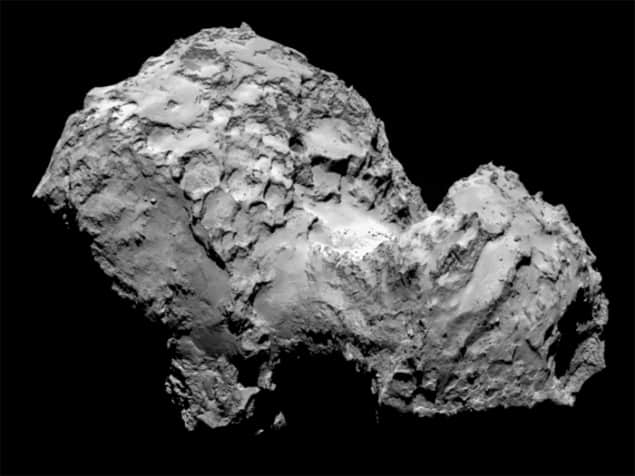
The European Space Agency’s Rosetta mission made history today, as it became the first spacecraft to rendezvous with a comet. After spending a decade in pursuit of the celestial body, Rosetta is now a mere 100 km from the comet’s surface, and will edge closer to it over the coming months as it studies the comet. The ultimate aim of the mission is to place its “Philae” landing module onto the comet’s surface in November.
Rosetta’s target, Comet 67P/Churyumov–Gerasimenko, is currently about 405 million km from Earth (about halfway between the orbits of Jupiter and Mars) and is hurtling towards the inner solar system at nearly 55,000 km/h. The comet’s 6.5-year elliptical orbit around the Sun takes it from beyond Jupiter to between the orbits of Mars and Earth. The spacecraft will accompany it for more than a year of its journey, as the duo swing around the Sun and back out towards Jupiter.
‘We are here’
“After 10 years, five months and four days travelling towards our destination, looping around the Sun five times and clocking up 6.4 billion kilometres, we are delighted to announce finally ‘we are here’,” says Jean-Jacques Dordain, director-general of ESA.
Rosetta’s journey to the comet saw it make three gravity-assisted flybys of Earth and one of Mars, to keep it on course since its 2004 launch. On its way, the spacecraft also passed by two asteroids – Šteins and Lutetia – and managed to gain excellent views and detailed measurements of the objects, revealing previously unknown information such as their core structures. Rosetta spent nearly 31 months in hibernation since it entered deep space in 2011, before the researchers sent a signal waking it up in January this year. The last of a series of 10 essential “rendezvous manoeuvres”, which began in May, to adjust Rosetta’s speed and trajectory to gradually match those of the comet were carried out today.
Rubber-ducky personality
According to the mission scientists, Comet 67P had already begun to “reveal its personality” while Rosetta was on its approach this year. Images taken by its OSIRIS camera between late April and early June showed that its activity was variable, with the comet’s gas and dust “coma” brightening up and dying down over six weeks. Other measurements made by the spacecraft showed that the comet was emitting water vapour into space at about 300 millilitres per second, and that its average temperature is about –70 °, indicating that the surface is predominantly dark and dusty rather than clean and icy. Last month, images taken from a distance of about 12,000 km began to reveal that the comet’s nucleus comprises two distinct segments joined by a “neck”, giving it a “rubber-ducky”-like appearance.
Comets are the primitive remainders of the clouds of dust and gas that served as the building blocks of our star system. In many ways, they are thought to have remained much the same during billions of years and should contain pure material from the early days of the solar system. There is also the possibility that comets could have brought with them the carbon-based organic molecules needed to start life on our planet and so comets are of great interest to researchers.
Over the coming six weeks, Rosetta will describe two triangular-shaped trajectories in front of the comet, first at a distance of 100 km and then at 50 km, before eventually edging as near as 30 km to attempt a close, near-circular orbit. While doing so, the suite of instruments on board will conduct a detailed scientific study of the comet, scrutinizing the surface for a target site for its Philae lander.
Possible landing sites
The mission hopes to identify as many as five possible landing sites by late August, before the primary site is chosen in mid-September. The final timeline for the sequence of events for deploying Philae – currently expected for 11 November – will be confirmed by the middle of October.
“Over the next few months, in addition to characterizing the comet nucleus and setting the bar for the rest of the mission, we will begin final preparations for another space-history first: landing on a comet,” says Matt Taylor, ESA’s Rosetta project scientist. “After landing, Rosetta will continue to accompany the comet until its closest approach to the Sun in August 2015 and beyond, watching its behaviour from close quarters to give us a unique insight and real-time experience of how a comet works as it hurtles around the Sun.”
- Take a look at the video below to see Rosetta’s orbit around the comet during the coming months.




